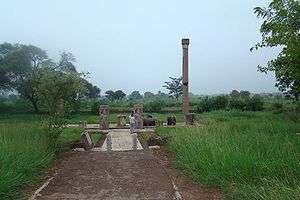Huna people
Hunas or Huna was the name given by the ancient Indians to a group of Central Asian tribes who, via the Khyber Pass, entered India at the end of the 5th or early 6th century. They occupied areas as far as Eran and Kausambi, greatly weakening the Gupta Empire. The Hunas were ultimately defeated by the Indian Gupta Empire and the Indian king Yasodharman.[2]
The Hunas are thought to have included the Xionite and/or Hephthalite, the Kidarites, the Alchon Huns (also known as the Alxon, Alakhana, Walxon etc.) and the Nezak Huns. Such names, along with that of the Harahunas (also known as the Halahunas or Harahuras) mentioned in Hindu texts, have sometimes been used for the Hunas in general; while these groups appear to have been a component of the Hunas, such names were not necessarily synonymous. The relationship, if any, of the Hunas to the Huns, a Central Asian people who invaded Europe during the same period, is also unclear.
In its farthest geographical extent in India, the territories controlled by the Hunas covered the region up to Malwa in central India.[3] Their repeated invasions and war losses were the main reason for the decline of the Gupta Empire.[4]
History
The Mongolian-Tibetan historian de:Sumpa Yeshe Peljor (writing in the 18th century) lists the Hunas alongside other peoples found in Central Asia since antiquity, including the Yavanas (Greeks), Kambojas, Tukharas, Khasas and Daradas.[5][6]
Chinese sources link the Central Asian tribes comprising the Hunas to both the Xiongnu of north east Asia and the Huns who later invaded and settled in Europe.[7] Similarly, Gerald Larson suggests that the Hunas were a Turkic-Mongolian grouping from Central Asia.[4] The works of Ptolemy (2nd century) are among the first European texts to mention the Huns, followed by the texts by Marcellinus and Priscus. They too suggest that the Huns were an inner Asian people.[8]

The 6th-century Roman historian Procopius of Caesarea (Book I. ch. 3), related the Huns of Europe with the Hephthalites or "White Huns" who subjugated the Sassanids and invaded northwestern India, stating that they were of the same stock, "in fact as well as in name", although he contrasted the Huns with the Hephthalites, in that the Hephthalites were sedentary, white-skinned, and possessed "not ugly" features:[10][11]
The Ephthalitae Huns, who are called White Huns [...] The Ephthalitae are of the stock of the Huns in fact as well as in name, however they do not mingle with any of the Huns known to us, for they occupy a land neither adjoining nor even very near to them; but their territory lies immediately to the north of Persia [...] They are not nomads like the other Hunnic peoples, but for a long period have been established in a goodly land... They are the only ones among the Huns who have white bodies and countenances which are not ugly. It is also true that their manner of living is unlike that of their kinsmen, nor do they live a savage life as they do; but they are ruled by one king, and since they possess a lawful constitution, they observe right and justice in their dealings both with one another and with their neighbours, in no degree less than the Romans and the Persians[12]
The Kidarites, who invaded Bactria in the second half of the 4th century,[13] are generally regarded as the first wave of Hunas to enter South Asia.
Religion
The religious beliefs of the Hunas is unknown, and believed to be a combination of ancestor worship, totemism and animism.[14]
Song Yun and Hui Zheng, who visited the chief of the Hephthalite nomads at his summer residence in Badakshan and later in Gandhara, observed that they had no belief in the Buddhist law and served a large number of divinities."[15]
Gallery
 Victory pillar of Yashodharman at Sondani, Mandsaur claiming victory over the Huns.
Victory pillar of Yashodharman at Sondani, Mandsaur claiming victory over the Huns. Asia in 500 CE, showing the Huna domain at its greatest extent.
Asia in 500 CE, showing the Huna domain at its greatest extent.- Nezak Huns king Napki Malka.
See also
Notes
- ↑ Hans Bakker 24th Gonda lecture
- ↑ India: A History by John Keay p.158
- ↑ Kurbanov, Aydogdy (2010). "The Hephthalites: Archaeological and Historical Analysis" (PDF). p. 24. Retrieved 17 January 2013.
The Hūnas controlled an area that extended from Malwa in central India to Kashmir.
- 1 2 Gerald James Larson (1995). India's Agony Over Religion. State University of New York Press. pp. 78–79. ISBN 978-1-4384-1014-2.
- ↑ Sumpa Yeshe Peljor's 18th century work Dpag-bsam-ljon-bzah (Tibetan title) may be translated as "The Excellent Kalpavriksha"): "Tho-gar yul dań yabana dań Kambodza dań Khasa [sic] dań Huna dań Darta dań..."
- ↑ Pag-Sam-Jon-Zang (1908), I.9, Sarat Chandra Das; Ancient Kamboja, 1971, p 66, H. W. Bailey.
- ↑ Hyun Jin Kim, The Huns, Abingdon, Routledge, passim.
- ↑ Joseph Kitagawa (2013). The Religious Traditions of Asia: Religion, History, and Culture. Routledge. p. 229. ISBN 978-1-136-87597-7.
- ↑ British Museum notice
- ↑ Procopius of Caesarea: Tyranny, History, and Philosophy at the End of Antiquity, Anthony Kaldellis, University of Pennsylvania Press, 2012, p.70
- ↑ Staying Roman: Conquest and Identity in Africa and the Mediterranean, 439–700, Jonathan Conant Cambridge University Press, 2012 p.259
- ↑ Procopius, History of the Wars. Book I, Ch. III, "The Persian War"
- ↑ History of Civilizations of Central Asia, Ahmad Hasan Dani, B. A. Litvinsky, Unesco p.119 sq
- ↑ Mircea Eliade; Charles J. Adams (1987). The Encyclopedia of religion. Macmillan. pp. 530–532. ISBN 978-0-02-909750-2.
- ↑ "The White Huns - The Hephthalites". Silkroad Foundation. Retrieved 11 January 2013.
- ↑ CNG Coins
- ↑ Iaroslav Lebedynsky, "Les Nomades", p172.
References
- Iaroslav Lebedynsky, "Les Nomades", Paris 2007, ISBN 978-2-87772-346-6
